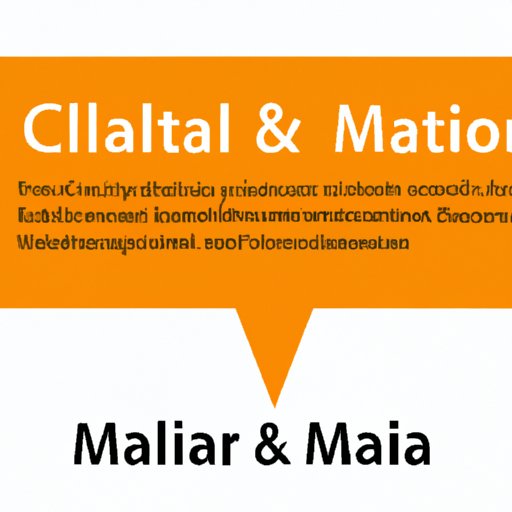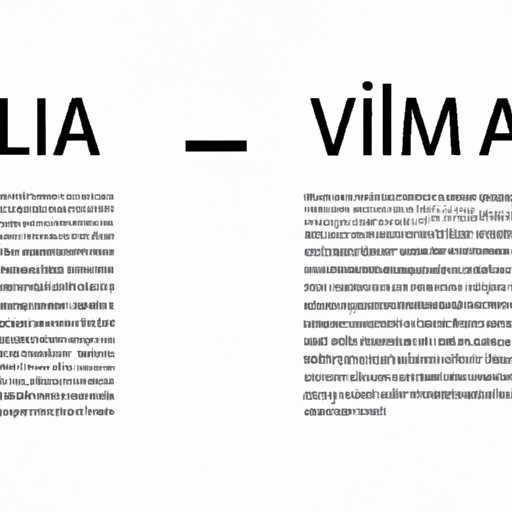
I. Introduction
Do you find yourself struggling to properly cite sources in your academic writing? Are you tired of losing points on your papers because of incorrect formatting or missing citations? Fear not, for this comprehensive guide will teach you everything you need to know about citing sources in MLA format.
MLA format is a widely used citation style, particularly in the humanities. Whether you are a college student or a professional writer, it is essential to understand and follow MLA guidelines for source citing. The purpose of this article is to provide an easy-to-follow guide for citing sources in MLA format, with tips, tricks, and hacks for beginners and advanced users alike.
II. 10 easy steps to master MLA citation format
Citing sources in MLA format can be daunting, especially if you’re new to the style. But with these 10 easy steps, you’ll become an MLA citation pro in no time:
- Understand basic MLA formatting rules, including margins, font size, and spacing.
- Identify the type of source you’re citing (book, website, journal article, etc.)
- For each source, collect the necessary information (author, title, publication date, etc.)
- Use in-text citations to acknowledge the source within your paper.
- Create a Works Cited page, listing all your sources alphabetically by author’s last name.
- For each source on the Works Cited page, follow the correct MLA citation format.
- Select the appropriate punctuation and formatting for each citation, including italics, quotation marks, and parentheses.
- Review your citations carefully to ensure accuracy and consistency.
- Edit and revise your citations as necessary.
- Use online citation generators or citation management software to streamline the process.
By following these steps, you’ll be able to confidently cite sources in MLA format, no matter what type of source you’re working with.
III. The importance of MLA format in academic writing
Citing sources correctly in academic writing is essential for two reasons:
- It gives credit to the sources you’ve consulted, ensuring that you are not plagiarizing other people’s work.
- It allows readers to locate and verify your sources, increasing the credibility of your research.
MLA format is a widely accepted citation style that provides a standard way to document sources in academic writing. It helps readers identify and locate the sources you’ve used, as well as providing a clear framework for acknowledging the ideas and research of others. A working knowledge of MLA format is necessary for any student or professional writer who wants to produce reliable, quality work in their field.
Here are some tips for avoiding plagiarism in your academic writing:
- Always properly cite any source you use, including books, articles, websites, and personal communications.
- Use quotes, paraphrases, or summaries only when necessary, and always provide attribution.
- Be careful not to rely too heavily on one source or to copy/paste large sections of text.
- Familiarize yourself with the conventions of MLA format so that you can accurately and effectively document your sources.
IV. Top 5 mistakes to avoid when citing sources in MLA format
Even experienced writers can make mistakes when citing sources in MLA format. Here are some common errors to watch out for:
- Missing information: Be sure to gather all the necessary information for each source, including author, title, and publication information. Missing data can result in incorrect or incomplete citations.
- Incomplete citations: Make sure your citations include all the required elements, such as the date of publication and page numbers. Incomplete citations can confuse your readers and make your work seem less credible.
- Inconsistent formatting: Be consistent in your use of italics, quotation marks, and other formatting elements. Creating a style guide for yourself can help you maintain consistency throughout your paper.
- Incorrect punctuation: Make sure to use the correct punctuation marks in your citations. Incorrect punctuation can change the meaning of your citation or make it difficult to read.
- Misunderstanding plagiarism: Plagiarism is not limited to copying and pasting entire passages from sources. It can also occur when you paraphrase or summarize someone else’s work without proper attribution. Be sure to always give credit where credit is due.
If you find yourself making any of these mistakes, don’t panic. There are several resources available to help you correct your citations and maintain accuracy and consistency throughout your paper.

V. MLA citation style guide for beginners
Are you new to MLA format and feeling overwhelmed? This beginner’s guide will provide you with a basic overview of MLA format, including the most important elements of a citation.
The basic format of an MLA citation is:
Author last name, First name. Title of Book. Publisher, Publication date.
For articles, the basic format is:
Author last name, First name. “Article Title.” Title of Periodical, Volume number, Issue number, Publication date, page numbers.
For websites, the basic format is:
Author last name, First name. “Webpage Title.” Website Title, Publication date (if available), URL (without http:// or https://).
It is important to include all the necessary information when creating a citation, as well as to format it correctly according to MLA guidelines. For example, book titles should be italicized, while article titles should be enclosed in quotation marks.
Remember, proper citation is essential for avoiding plagiarism and ensuring the accuracy and credibility of your research.
VI. Citing sources in MLA format: A guide for college students
College students are often required to use MLA format when citing sources in their research papers. This guide provides an overview of MLA format, as well as tips and tricks for navigating the style.
The basic structure of an MLA paper includes:
- A heading (with your name, instructor’s name, course title, and date)
- An introduction
- Body paragraphs that support your thesis
- A conclusion
- A Works Cited page listing all your sources
When citing sources, you should:
- Use in-text citations to acknowledge the source within your paper.
- Create a Works Cited page, listing all your sources alphabetically by author’s last name.
- Follow the correct MLA citation format for each source on the Works Cited page.
For electronic sources, such as websites and online articles, you should also include the date of access and the URL of the source. By following these guidelines, you can ensure that your citations are accurate, complete, and consistent throughout your paper.
VII. MLA citation hacks: How to save time and avoid stress
Citing sources in MLA format can be time-consuming and stressful, but there are several hacks you can use to streamline the process:
- Use an online citation generator, such as Citation Machine or EasyBib, to create accurate citations.
- Look up citations online using resources such as JSTOR or Google Scholar.
- Use citation management software, such as Mendeley or Zotero, to organize your sources and create citations automatically.
- Create a style guide for yourself, which includes formatting rules and common citations, to save time when creating citations.
- Ask your instructor or librarian for help if you’re unsure how to cite a source.
By using these hacks, you can save time and reduce stress when citing sources in MLA format.
VIII. MLA format in the real world: How to use citations in your professional life
Even outside of academia, MLA format can be useful for citing sources in your professional life. Whether you’re writing a grant proposal or a business report, following MLA guidelines for source citing can enhance the credibility and professionalism of your work.
Here are some tips for using MLA format in your professional writing:
- Always cite your sources properly, using the correct MLA citation format.
- Double-check the accuracy and completeness of your citations.
- Use in-text citations to acknowledge the ideas and research of others.
- Include a Works Cited section at the end of your document.
- Familiarize yourself with the most common types of sources used in your field, and use appropriate citations for each.
By using MLA format in your professional writing, you can demonstrate your attention to detail and your commitment to using reliable and accurate sources.
IX. Conclusion
Mastering MLA citation format can seem daunting, but with the tips, tricks, and resources provided in this guide, you can be confident in your ability to accurately and effectively cite sources in MLA format. Remember, proper citation is essential for avoiding plagiarism, enhancing the credibility of your research, and achieving success in your academic and professional endeavors.





